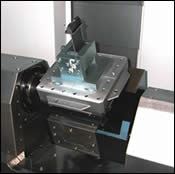Making Chips Vs. Making Value
In a cycle that is 90 percent grinding and 10 percent more basic metal cutting, letting the grinder perform the last 10 percent may make sense.
Share




Does this picture alarm you? The precision CNC grinding machine in this photo just finished doing what any machining center could do. That is, it drilled the two holes that can be seen in the workpiece, in the close-up on the next page. Just before the grinding wheel was loaded here, the machine’s spindle carried a drill. Was it a waste to let this high-end machine do such basic machining?
Chris Stine of United Grinding (Miamisburg, Ohio) says no, not necessarily. The Mägerle grinder shown offers the ability to use milling and drilling tools in addition to abrasive wheels, and the holes needed to locate relative to the same datums as the root form that will be ground. Therefore, why not perform the drilling as part of the same setup as the grinding? In a cycle that is 90 percent grinding and 10 percent more basic metal cutting, Mr. Stine says, letting the grinder perform the last 10 percent makes sense. Even so, he says that many users who can see the logic in this assertion still have trouble watching their expensive machine do such work.
Others offering different metalworking technologies have commented on the same reticence. Far from the world of grinding, for example, a similar mindset limits the use of spindle-mounted probes on machining centers. Locating or measuring a part through probing on a CNC machine may make sense in the abstract, but in reality, it can be hard to watch a machine tool spend time on motion that does not directly involve material removal.
CNC machines have steadily become more capable at effectively carrying out a range of related operations in one cycle. Could an unexamined bias in your own shop be holding back how well you put this capability to use? Specifically: Are you hindered by the sense that each machine tool should only spend its time doing the most obviously valuable work it can do?
In the photo, consider the savings that result from drilling the holes on this grinding machine. The part is spared additional handling and an additional setup on a machining center.
Consider also why this or any machine tool is purchased in the first place. It is bought not to make chips, but to make value. And that value is sometimes realized not only by doing work, but also by avoiding costly extra work elsewhere in the process.
Related Content
-
Quick-Change Tool Heads Reduce Setup on Swiss-Type Turning Centers
This new quick-change tooling system enables shops to get more production from their Swiss turning centers through reduced tool setup time and matches the performance of a solid tool.
-
Lean Approach to Automated Machine Tending Delivers Quicker Paths to Success
Almost any shop can automate at least some of its production, even in low-volume, high-mix applications. The key to getting started is finding the simplest solutions that fit your requirements. It helps to work with an automation partner that understands your needs.
-
Ballbar Testing Benefits Low-Volume Manufacturing
Thanks to ballbar testing with a Renishaw QC20-W, the Autodesk Technology Centers now have more confidence in their machine tools.



























